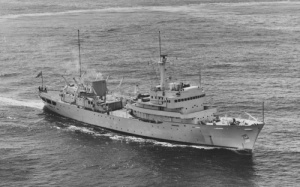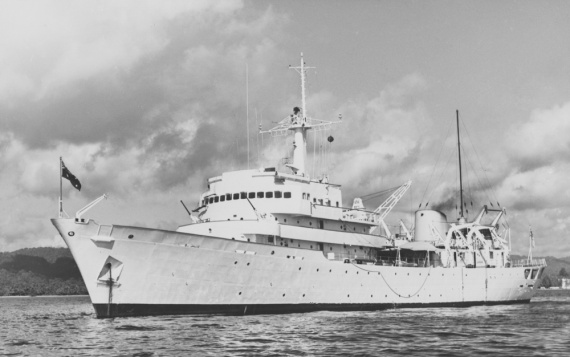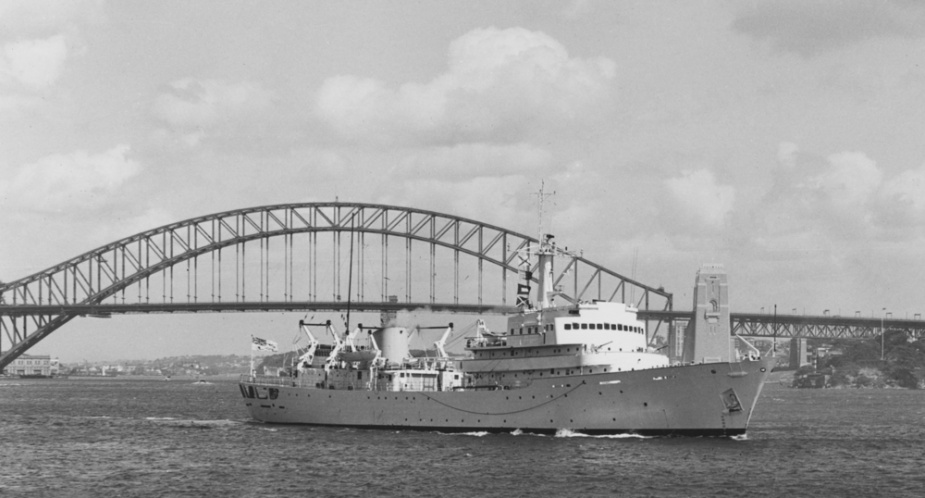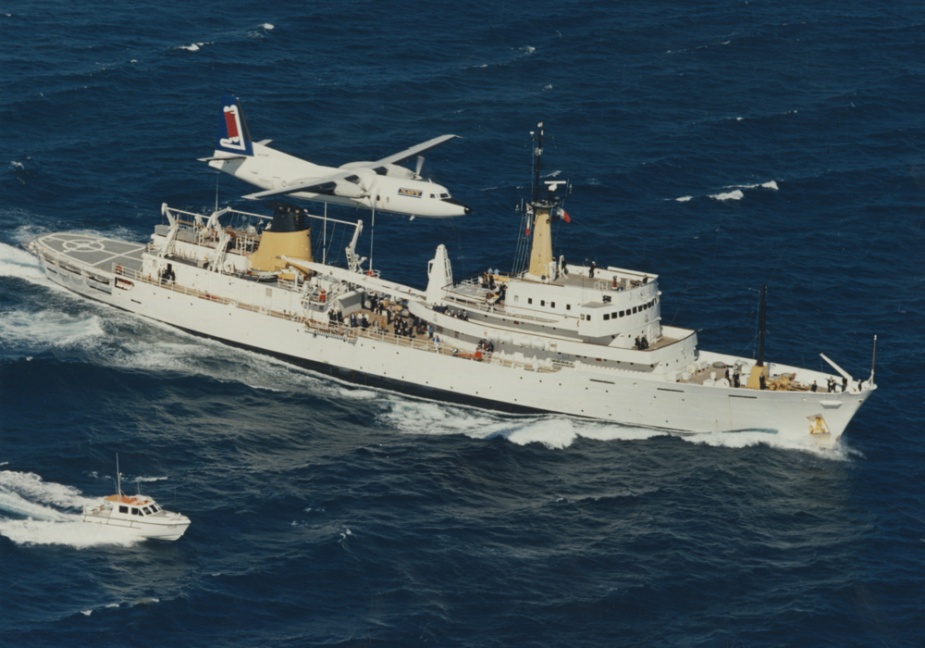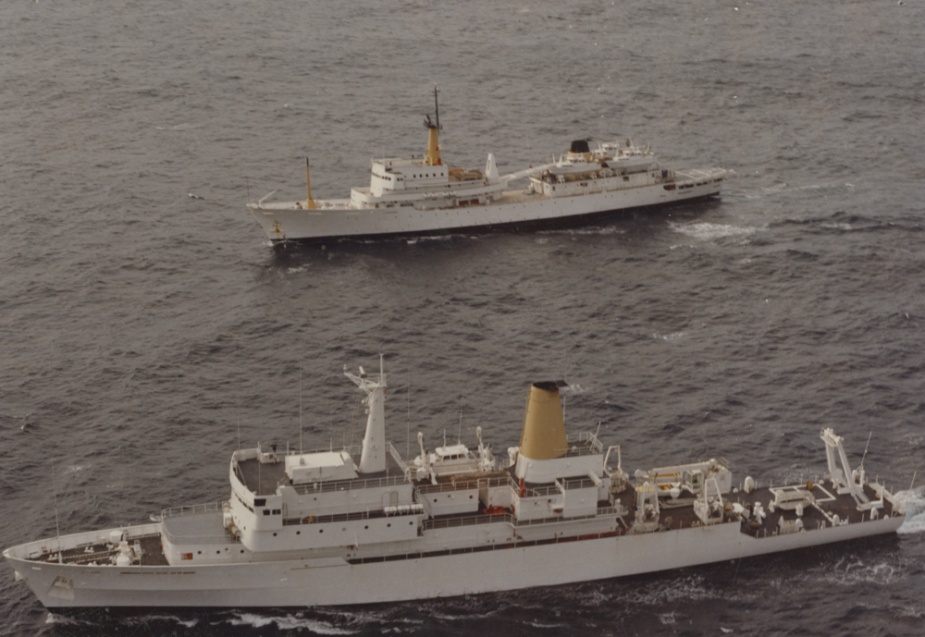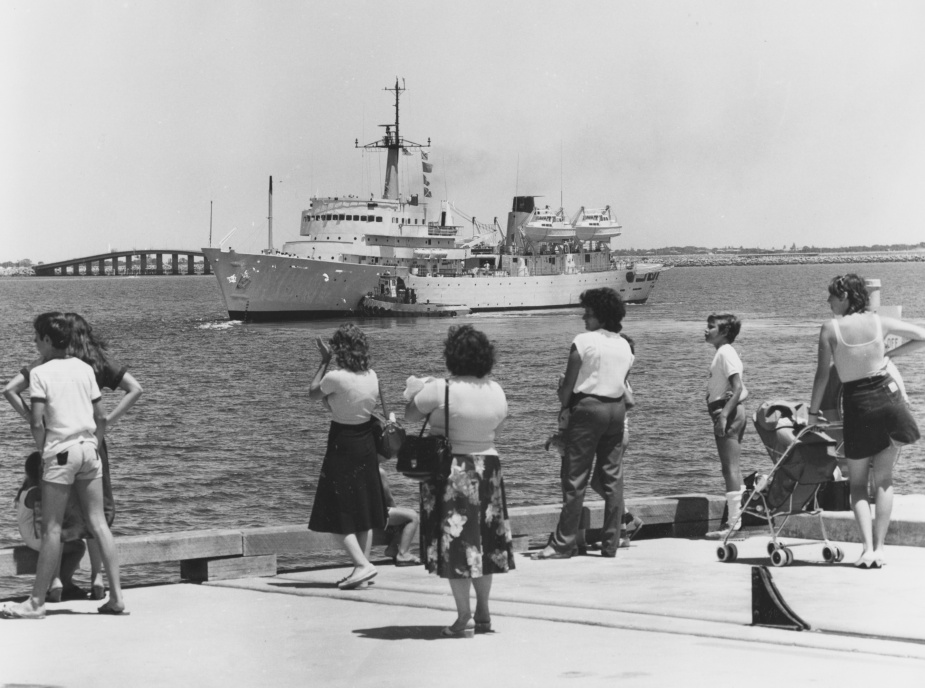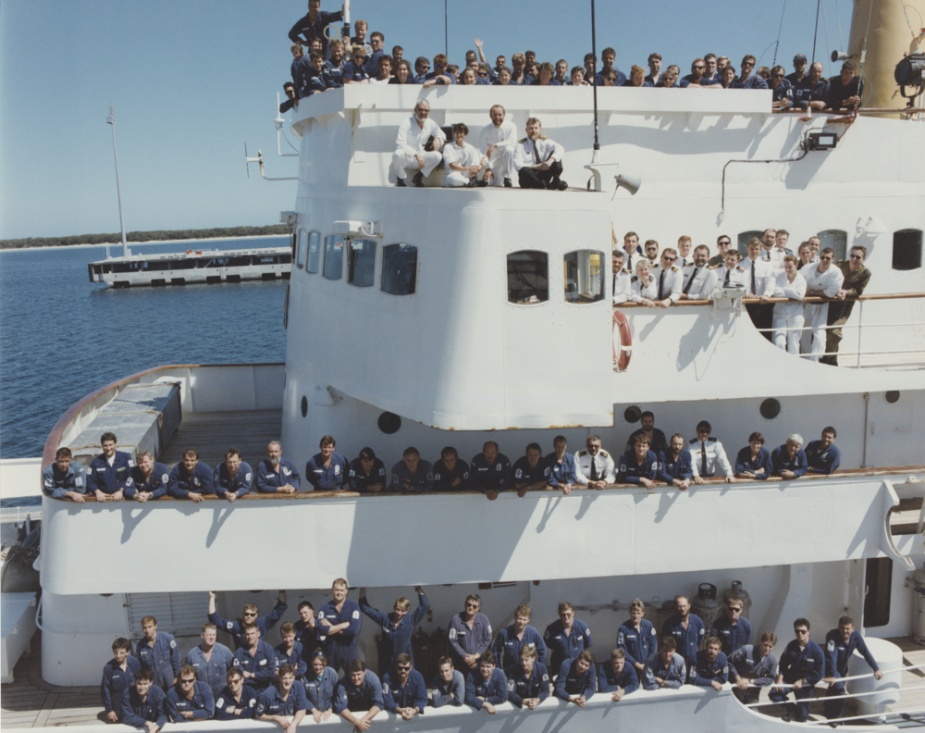HMAS Moresby (II)
| Class |
Moresby Class |
|---|---|
| Type |
AGS |
| Pennant |
AGS73 |
| Motto |
With Science and Vision |
| Builder |
NSW State Dockyard, Newcastle |
| Laid Down |
1 June 1962 |
| Launched |
7 September 1963 |
| Launched by |
Mrs Winifred (Wendy) Gatacre, wife of Rear Admiral GGO Gatacre, CBE, DSO, DSC* |
| Commissioned |
6 March 1964 |
| Decommissioned |
13 November 1997 |
| Fate |
Sold and renamed MV Patricia Anne Hotung |
| Dimensions & Displacement | |
| Displacement | 2540 tonnes |
| Length | 96 metres |
| Beam | 13 metres |
| Draught | 4.2 metres |
| Performance | |
| Speed |
|
| Range | 10,000 nm radius |
| Complement | |
| Crew | 140 officers and sailors |
| Propulsion | |
| Machinery | Diesel electric; 3 diesel main engines driving twin electronic motors/screws |
| Horsepower | 5000 bhp |
| Armament | |
| Guns | 2 x 40mm Bofors (removed in 1973) |
| Awards | |
| Inherited Battle Honours | |
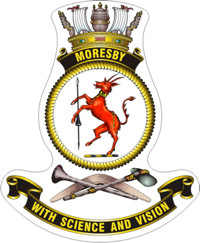
In 1956 the Royal Australian Navy (RAN) commenced the first of a series of five year charting programmes, which quickly revealed the inadequacies of the converted warships HMA Ships Barcoo (II) and Warrego (II), for the task. The two ships, along with HMAS Diamantina (I) following her conversion for surveying operations, performed admirable work, however, the need for a purpose built surveying vessel was obvious.
On 26 November 1959, the then Defence Minister, Mr Athol Townley MP, announced that fixed wing naval aviation would cease in the RAN in 1963. This would free up resources enabling funds to be directed towards the procurement of a new hydrographic survey ship, the first RAN vessel specifically designed for the role, fitted out with cutting edge equipment and a full flight deck for embarked helicopter operations. It transpired that fixed wing naval aviation received a reprieve but this did not affect the hydrographic ship’s acquisition. The hydrographic service was given complete freedom to determine its own specifications for a vessel of about 2000 tons. The proposal was submitted to the Navy Board for inclusion in the 1960 naval programme and that November, the Minister for the Navy, Senator John Gorton, confirmed that the proposal had been approved. The final design phase for the ship was undertaken by the Australian Shipbuilding Board to the specifications set out by the RAN and the hydrographic service.
HMAS Moresby (II) was subsequently laid down at the State Dockyard, Newcastle on 1 June 1962, and was launched by Mrs Winifred (Wendy) Gatacre, the wife of the Flag Officer in Charge East Australian Area, Rear Admiral GGO Gatacre, CBE, DSO, DSC*, on 7 September 1963. Among the official guests attending the launch was Mrs Burtin Phillips, the granddaughter of Vice-Admiral John Moresby, RN, after whom Moresby was named. The launching ceremony was one of the highlights of the 1963 Mattara Festival, and some 5000 spectators lined vantage points to witness the ship enter the water.
The launch of the ship had been placed in jeopardy when just three weeks earlier she appeared to be the victim of sabotage. On the morning of 14 August 1963, a tradesman working in the ship noticed that some electrical cabling had been cut. Subsequent investigation found that the damage to the cables was not confined to one section of the ship, but was distributed through several sections. Newcastle CIB and naval authorities were notified, and an investigation conducted, however the saboteur was never identified. Thankfully no further damage was done to the ship and the launch date was not affected.
Following completion but prior to commissioning, Moresby embarked a Westland Scout AH-1 helicopter from 723 Squadron on 8 January 1964 for deck landing trials, and the ship later conducted sea trials in January and February. The squadron operated two Scouts, which rotated aboard the survey ship. The Scouts represented a vast improvement on the seaplanes that had previously been used in this role and proved the practicality of operating helicopters from small ships. They did, however, require a higher level of maintenance work than other aircraft as the abrasiveness of coral sand eroded the rotor blades as well as the engine and airframe structure. Moresby carried three 34-foot survey motor boats (SMB), equipped with echo sounders to assist in surveying operations and, fitted with sleeping berths and galleys, were designed to operate independently for extended periods away from the ship. Also embarked were two 27-foot whalers, later replaced by two 5m aluminium light utility boats; two Land Rover 4 wheel drive vehicles with trailers; two inflatable rubber rafts to land the vehicles ashore in remote areas; and a three-ton electric crane to lift and recover gear over the side. There was also space on board to accommodate sea riders from organisations such as the CSIRO and universities when conducting scientific research at sea. Moresby also provided hydrographic training for officers and sailors of the RAN and other navies.
Moresby sailed from Newcastle to Sydney on 13 February 1964, flying the Red Ensign. At the half-way mark of the voyage, a brief handover ceremony was conducted off Norah Head and Captain Antony Cooper, ADC, RAN, accepted Moresby on behalf of the RAN. The Red Ensign was hauled down and the White Ensign run-up in its place. Moresby officially commissioned on 6 March under the command of Commander John Osborn, RAN, at Garden Island in Sydney. At that time she was one of the most advanced vessels of her type in the world.
After a brief period of trials Moresby got straight to work, and by the end of the calendar year had travelled some 47,830 nautical miles completing surveys in the approaches to Port Jackson, NSW; Storm Bay, D’Entrecasteaux Channel, Port Cygnet, Frederick Henry Bay and Norfolk Bay, Tasmania; Cleveland Bay, Rockingham Bay and the Brook Islands, Queensland; and in the Torres Strait in company with HMAS Bass, which included a visit to Port Moresby. Survey operations in the Torres Strait were interrupted on 9 November, when Moresby received a distress message from the fishing boat Phaleron which had run aground on Orman Reef north east of Mabuiag Island. Bass recovered the five crewmen and landed them at Thursday Island.
Following a refit at the beginning of 1965, Moresby was back in Tasmanian waters from April to June, conducting surveys off the state’s south east coast. The value of Moresby’s embarked Scout helicopter was evident on 22 April when, in just one hour, the aircraft landed a ‘Hi-Fix’ station at Fisher Point, Recherche Bay. Previously this was a day-long operation conducted by boat. Later in the year, four months were spent conducting surveying operations off the north west coast of Western Australia, in company with HMA Ships Diamantina (I), Gascoyne (I) and Bass. This included visits to Singapore and Bangkok in October and November. En route to Western Australia, Moresby’s Scout located a missing dinghy and crewman from MV Southern Endeavour in the evening of 18 August, about 16 nautical miles north west of Booby Island. The dinghy had struck a turtle and overturned late the previous day. The relieved crewman was recovered by Moresby, having spent 23 hours in the water with only two bottles of beer for sustenance.
Her surveys in 1966 saw Moresby steam some 92,797 nautical miles from the east coast of Tasmania, where she conducted surveys in Georges Bay, Banks Strait and Bass Strait; New South Wales where she surveyed the approaches to Batemans Bay; Queensland where she conducted a check survey in the Gannet Passage; and back into Western Australian waters where she conducted surveys in and around Baleine Bank, Lacepede Channel, Adele Island and the western approaches to Yampi Sound.
Much of 1967 was spent in Papua New Guinea waters, conducting extensive surveys along the north coast. Moresby arrived at Madang on 6 April. Two days later at Wewak, Moresby’s Scout, about to conduct a reconnaissance flight, lost directional control on take-off and ditched into the water in Wewak Harbour. All of the aircraft’s occupants escaped uninjured. Moresby’s Commanding Officer, Commander Hugh Dillon, was aboard the helicopter at the time of the accident and displayed remarkable composure by staying with the aircraft until it reached the seabed. Having survived a previous helicopter crash in 1958, Commander Dillon was mindful of the danger posed by rotor blades in motion. The Scout was recovered in just four hours but was irreparable. A replacement helicopter was flown from HMAS Albatross to Shoalwater Bay, occasionally landing on the highway to refuel at local service stations.
Moresby returned to Sydney in July for a maintenance period, before conducting a survey in Jervis Bay in November and returning to Papua New Guinea later that month to conduct important survey work around the islands to the east and north-east of the mainland. There was a brief respite from survey operations when she spent the Christmas and New Year period in Cairns, before departing for PNG again on 3 January 1968 and returning to Australia in May.
Moresby later conducted surveys in Shoalwater Bay, Queensland, before proceeding to Western Australian waters for further operations. She made brief visits to Singapore and Jakarta in October, returning to Sydney on 12 December where she remained for the following eight months undergoing a refit, receiving major upgrades to her hydrographic equipment. She was back at sea in northern Australian waters in August 1969 working off the coasts of far north Queensland and the Northern Territory.
Returning to far north Queensland in 1970, Moresby conducted surveys in the Gannet Passage and Torres Strait, and also in Western Australian waters north and south of Broome. She paid visits to Port Moresby in March/April and Surabaya in September. On 29 April she participated in the Bicentenary commemorations of Captain James Cook’s historic landing at Kurnell in Botany Bay. Alongside the Kurnell Oil Jetty, Moresby paraded a guard to salute Her Majesty Queen Elizabeth II as she observed the Bicentenary re-enactment from HMY Britannia. The event was also attended by ships from the UK, USA, New Zealand, Japan, Argentina, Colombia, Canada, Norway, Chile, Indonesia, the Netherlands, Portugal and France.
Moresby visited Victorian waters toward the end of the year, conducting surveys around Wilsons Promontory in November and December.
The new year saw Moresby return to PNG to conduct surveys in the Gulf of Papua in February, March and April 1971. She returned to Sydney on 22 April, where she underwent a refit before sailing for northern Australian waters to conduct soundings around Cartier Island and Red Island, and surveys in Western Australian waters in the approaches to Troughton Passage and Lesueur Island.
The first half of 1972 was spent conducting her first surveys in South Australian waters in the Yatala Passage, Denial Bay, the Nuyts Archipelago, the Pearson Isles and Port Stanvac. She returned to Sydney in June before once again proceeding west to operate in Western Australian waters, including the important shipping route approach to Port Walcott, one of the Pilbara’s major iron ore exporting ports and one of the busiest ports by tonnage in Australia. Moresby again visited Jakarta that October.
In 1973 Moresby undertook one of the most significant surveys of her commission. Over the course of six months, punctuated only by eleven days in Sydney for maintenance, she surveyed a channel through Swain Reefs in the southern part of the Great Barrier Reef for the world’s largest bulk carriers. Supported by a small fleet of Attack Class patrol boats, Moresby recorded more than 340,000 depth soundings to chart the 32km wide safe passage through the reef. The opening of the passage enabled bulk carriers, in excess of 100,000 tonnes, access to ports like Gladstone and Rockhampton, saving them a 500km detour into the open sea.
Moresby returned to Sydney in late July and commenced a six-month refit in August, during which her Bofors guns were removed and a new crane installed. By the time she returned to sea in February 1974, she embarked the Navy’s new Bell 206B-1 Kiowa helicopters, which had replaced the Westland Scouts. Survey operations throughout the year were conducted in South Australia, Tasmania, Western Australia, the Northern Territory and the Monte Bello Islands.
1974 was notable for the number of search and rescue, and Medical Evacuation (MEDEVAC) operations Moresby was required to participate in. In February while in Tasmanian waters, the ship’s aircraft transported a lighthouse keeper to Hobart for urgent dental treatment, and two weeks later, on 3 April, she evacuated a sailor from the Japanese fishing vessel Koei Maru No. 28 to Hobart when he suffered an abdominal injury some 500 nautical miles off the Tasmanian coast. Both the Japanese Maritime Safety Agency and Koei Maru’s owner signalled their appreciation for the rescue and the excellent treatment the injured sailor received aboard Moresby. Later, on 26 June while surveying near the Geelvink Channel, Western Australia, the ship was tasked to search for the crew of a fishing vessel which had foundered off Kalbarri. The three crew members were located at the base of the Zuytdorp Cliffs, about 16km north of Kalbarri, by Moresby’s Kiowa on the second day of the search. They were later rescued by a police land party, suffering only from exhaustion and minor cuts and bruises.
That November, Moresby moved to her new home port of Fremantle after more than a decade of home porting at Sydney.
Surveys in 1975 were conducted around Cone Bay and Joseph Bonaparte Gulf in the Northern Territory; and Cape Naturaliste, the approaches to Bunbury, Bouvard Reefs, Geographe Bay and Cape Leeuwin in Western Australia. That July Moresby embarked some 18 tonnes of artefacts from the infamous Dutch East India Company shipwreck Batavia, from Houtman Abrolhos for transport to the Western Australian Maritime Museum in Fremantle.
On 29 October Moresby was directed to rendezvous with the Japanese fishing trawler Fujisaie Maru No. 6. An altercation on board had left the trawler’s radio operator dead and her boatswain suffering from serious stab wounds. Moresby’s Kiowa evacuated the injured sailor to HMAS Leeuwin the following morning.
Survey work in the first half of 1976 was once again conducted in Western Australian waters around Ronsard Island, and from Cape Naturaliste to Direction Bank, but the highlight of the year for Moresby was a voyage to the Seychelles in June to celebrate the former British colony’s independence. The occasion marked the end of 166 years of British colonial rule, and was attended by naval representatives from Britain, France, the USA, India and Iran. Members of Moresby’s crew took part in many of the events ashore in Port Victoria, and the ship’s Kiowa participated in a flypast. Moresby also embarked two large tortoises, a male and a female, as a gift to the Perth Zoological Gardens from the new Seychelles Government. Upon her return to Australia, Moresby entered refit on 1 July.
Moresby returned to sea on 7 January 1977, with her survey operations for the year being conducted, once again, primarily in Western Australian waters around Cape Leeuwin, King Sound, Collier Bay and Yampi Sound. On 12 July she suspended surveying operations in Yampi Sound to conduct a search for a Vietnamese refugee boat, reported by a passing pleasure craft to be in York Sound. The ship’s Kiowa located the 70ft vessel the following day carrying 27 adults and 20 children, ranging in age from two to sixty years. Moresby resupplied the boat, and a medical officer, Surgeon Lieutenant Commander Ken Shepherd, RANR, boarded her to conduct medical checks on her passengers. A steaming party was also embarked to supervise the subsequent passage to Broome where the vessels arrived on 15 July ending a nine-and-a-half week voyage for the refugees.
Less than two weeks later on 28 July, Moresby’s Kiowa helicopter crashed on Sunday Island in King Sound when a rotor blade struck a rock on a cliff face, and the aircraft fell on to the rocks some 20m below. The aircrew escaped with only minor injuries. The aircraft, however, was swept away by the tide and subsequently located nearly 25km away in Cygnet Bay.
Moresby was fully employed in the final two years of the 1970s conducting surveys in Western Australian waters, including in and around Cape Leeuwin, Cape Naturaliste, King George Sound, Rottnest Island, Geelvink Channel, Nuyts Point, Bald Island and Dongara; and in Northern Territory waters in Joseph Bonaparte Gulf. In July 1978 she transferred from Fremantle to Fleet Base West, HMAS Stirling, which was to be her final home port.
In November 1979 Moresby performed the role of radio relay and support ship for the Cape Town to Fremantle leg of the Parmelia Yacht Race, a feature event of Western Australia’s 150th Anniversary celebrations. The race emulated the voyage of the barque MV Parmelia when she conveyed the first European settlers from Plymouth in England to the Swan River Colony in 1829, a voyage of more than 10,500 nautical miles. Also embarked were an observer from the Royal Perth Yacht Club, two journalists, and three geologists from Monash University and the Bureau of Mineral Resources who were to study manganese nodules; a particular type of rock concretion on the sea bed. On 21 November the ship rendezvoused with the race competitor Seltrust Endeavour to MEDEVAC an injured crewman. The ship’s helicopter winched the sailor off the yacht to Moresby and he stayed with the ship until she reached Fremantle on 25 November.
The new decade saw Moresby once again fully engaged in hydrographic operations in Western Australian and Northern Territory waters around Albany, West Cape Howe, Cape Riche, Joseph Bonaparte Gulf, Charles Point Patches, Esperance, the mouth of the Victoria River, Exmouth Gulf, Mauds Landing and North West Cape. In June 1981 she visited Jakarta, the first overseas visit for a large proportion of the ship’s company, in order to maintain the excellent relations between the hydrographic services of the two nations. On 14 June, during the ship’s return journey to Australia, she passed within 400m of a smouldering Mount Krakatoa. That August the ship’s Kiowa flight was awarded the McNicoll Trophy, awarded to the Fleet Air Arm unit with the best flying safety record over the previous year. The flight went on to win the award again in 1982 and 1983.
Surveys in 1982 and 1983 were conducted around Dongara to Cape Leschenault, Escape Island, the Recherche Archipelago and Lancelin in Western Australia; Joseph Bonaparte Gulf in the Northern Territory; and the Cocos and North Keeling Islands in the Indian Ocean.
In March 1983 Moresby was directed to observe the recovery of a Soviet space vehicle within Australia’s region of maritime interest. The vehicle was an unmanned BOR-4 orbiter, a prototype of the later Buran orbiter, but bore a design similar to the earlier Soviet Spiral Space Plane (the BOR-5 prototype had a design which more closely resembled the ultimate Buran design; similar to NASA’s space shuttle). It splashed down in the Indian Ocean on 16 March, some 300 nautical miles south of the Cocos Islands where Moresby’s Kiowa and a RAAF P3C Orion aircraft filmed the recovery operation, which lasted for about four hours. The images of the top-secret operation were subsequently seen around the world, prompting the Soviet authorities to reschedule all future space missions to conclude in the Black Sea.
Moresby again visited Jakarta in June before recommencing survey operations in Western Australian waters. However, persistent defects in her main engines forced her to suspend surveying operations and return to Stirling in November to effect repairs. The necessary maintenance kept her alongside at Stirling for five months, although her SMBs continued to perform useful survey operations while the ship was alongside.
Moresby resumed survey operations upon her return to sea in April 1984, carrying out surveys around Stirling as well as surveying the America’s Cup race sailing course. In August she supported the National Parks and Wildlife Association’s studies at Christmas Island before returning to Stirling later that month to begin preparations for a scheduled refit.
She returned to sea at the end of February 1985, and resumed what proved to be a very busy year of survey operations around Shark Bay and the Houtman Abrolhos in Western Australia; and Joseph Bonaparte Gulf in the Northern Territory. She visited Singapore in August and September, and steamed more than 100,000 nautical miles over the course of the year.
The new year began with yet another rescue for the ship’s helicopter. On 31 January 1986, two shell divers became stranded on Figure of Eight Island near Esperance when their boat, Orca II, ran aground on a reef. Moresby was alongside at Esperance at the time, and nine hours later her helicopter retrieved the two divers after receiving assistance from RAAF and civilian aircraft to triangulate their position. The two divers were fortunate that not only was Moresby in the area, but that her helicopter was operational - an engine defect had grounded the aircraft for six days earlier in the month.
The helicopter suffered a second, more serious mechanical defect on 14 April while approaching the ship after assisting with the calibration of hydrographic equipment at Gibson Point in the Admiralty Gulf, Western Australia. The aircraft lost power at a height of some 30 metres and crashed into the sea. The three-person crew escaped uninjured, and the aircraft was recovered, with the exception of its rotor and transmission, by Moresby’s SMBs and crane. A replacement aircraft was embarked the following month.
The ship commenced a scheduled refit in July 1987 and returned to sea that December, however problems with the ship’s new Simrad Sonar kept her alongside for much of the next few months, undergoing defect rectification. She resumed surveying operations at the end January 1988.
Surveys in 1988 were conducted around Barrow Island, Mary Anne Passage, Exmouth Gulf and Airlie Island in Western Australia; and Hogan Island and the Tamar River entrance in Tasmania.
In the afternoon of 18 April Moresby was requested by Western Australia Police in Onslow to assist in the search for a man lost overboard from the fishing vessel Grey Ghost in the vicinity of the Mangrove Islands. The ship’s Kiowa helicopter was dispatched to search by air while Moresby coordinated the search efforts of two other aircraft and fishing vessels with the Onslow Police. The man was spotted on Large Island, some 25km north east of the Mangrove Islands, the following morning. Moresby’s Kiowa recovered the man and returned him safely to Onslow.
Tropical Cyclone Herbie hindered surveying operations in May, forcing the ship to withdraw surveying teams ashore and take shelter around Airlie Island. The following month while Moresby was alongside at Stirling undergoing maintenance, the ship’s helicopter and crew members were detached to North West Cape where they operated from the Harold E Holt Naval Communications Station until 4 October, in support of Operation NORTHERN FALCON. The aircraft flew a number of surveillance sorties around the perimeter of the station during anti-US demonstrations at the base.
The ship returned to the east coast of Australia to participate in the Bicentennial Naval Salute in September. After spending two days in Jervis Bay with the rest of the gathering fleet, Moresby entered Sydney Harbour for the first time in 14 years, on 25 September. She embarked 30 members of the media and took up a position off South Head to witness the gun salutes by representative visiting warships. Ten vessels from ten nations each fired a 21 gun salute as they steamed into Sydney Harbour, which was answered after the final salute by the guns of the ‘Sirius Battery’, temporarily established in one of the World War II-era gun emplacements at HMAS Watson.
The following day Moresby joined Group Five consisting of HMAS Stuart, JDS Shimayuki, FNS Amiral Charner and PNS Tughril for the Fleet Entry, which saw some 40 vessels enter Sydney Harbour in formation over the course of two days. A busy week of Bicentennial celebrations culminated in a Fleet Review, conducted by His Royal Highness Prince Andrew, Duke of York, embarked in HMAS Cook on 1 October, while the ship’s aircraft took part in the Fleet Review flypast.
Moresby made a rare port visit to Adelaide in November, where she berthed for the first time since May 1972. There, the ship’s helicopter provided aerial support for the Australian Formula 1 Grand Prix.
Survey operations in 1989 were conducted off the south coast of Western Australia between Esperance and Bremer Bay; and around the Wessel and English Company Islands in the Northern Territory. The ship underwent an extended maintenance period during the first half of the year, during which she was fitted with the new Hydrographic Logging and Data Processing System (HYDLAPS), a sophisticated navigation and data collection system designed specifically for hydrographic operations. HYDLAPS sea trials were conducted in June and July, and Moresby made a week-long visit to Singapore in August coinciding with Singapore National Day on the 9th.
Survey operations in 1990 were conducted around King George Sound and off Cape Naturaliste in Western Australia, and once again in the Wessel Islands and English Company Islands groups in the Northern Territory. The ship also paid another visit to Singapore in early November.
Moresby spent the early part of 1991 conducting surveys around Melville Island in preparation for the following year’s Exercise KANGAROO, before entering refit in Fremantle in May. With the ship rapidly approaching 30 years of age, a large amount of required maintenance became apparent once she was out of the water, which almost doubled the original work package. However, her scheduled completion was only delayed by two weeks and the refit officially completed on 22 November.
Survey operations in 1992 were conducted between Esperance and Albany in Western Australia, during which the ship supported Laser Airborne Depth Sounder (LADS) system trials; and the Wessel Islands, Cadell Strait and the Crocodile Islands in the Northern Territory. The ship then paid a brief visit to Bali from 30 July to 2 August.
At 11:41am on 31 October, a Saturday morning, in position 11 36.29’S, 135 38.33’E off Arnhem Land, Moresby became the first RAN vessel to steam one million nautical miles. The ship was appropriately running a survey line at the time. She anchored in Refuge Bay at Elcho Island that evening to celebrate the event.
Moresby conducted a series of scientific trials and oceanographic observations in the early parts of 1993, in conjunction with the Defence Science and Technology Organisation (DSTO) and Australian Defence Force Academy (ADFA). She conducted a series of oceanographic observations over the full extent of the continental shelf between Darwin and the Monte Bello Islands in April and May, and also took measurements of the Leeuwin Current using an Acoustic Current Doppler Profiler from May to July.
Later, in September, she conducted an unsuccessful search for two Consolidated PBY Catalina flying boats scuttled off the Western Australian coast after World War II, before proceeding back to northern Australian waters to recommence survey operations around the Wessel Islands and Crocodile Islands.
Survey operations in 1994 were conducted in Spencer Gulf in South Australia, using the High Frequency Differential Geographical Position System as the primary positioning system for the first time; and around the Wessel and Crocodile Islands groups in the Northern Territory. She visited Surabaya in Indonesia in late October, and upon her return to Stirling in December began preparations for a refit scheduled to commence in the new year.
A delay in the delivery of the ship’s replacement main engine camshafts saw the refit completion date delayed by some two months. Moresby returned to sea for post-refit trials in August 1995, beginning shakedown and workup exercises the following month. She conducted a brief survey in Spencer Gulf, before visiting Sydney at the end of September to celebrate the 75th Anniversary of the RAN Hydrographic Service, the ship’s first visit to Sydney since the Bicentennial Naval Salute in 1988. She went on to visit Wollongong, the home of the Australian Hydrographic Service, in company with HMAS Flinders in early October to continue events associated with the 75th Anniversary, including the 75th Anniversary Ball on the 6th. Moresby departed Wollongong on 9 October and returned to the Spencer Gulf survey area, punctuated by a visit to Hobart at the end of the month.
1996 saw Moresby circumnavigate the continent and survey Cambridge Gulf in Western Australia; Melville Island, Beagle Gulf and Sahul Banks in the Northern Territory; and a proposed Outer Great Barrier Reef Deep Water Route in the Coral Sea, during which she made rare port visits to Cairns, Townsville and Mackay. In November, upon the conclusion of her Great Barrier Reef survey, Moresby visited Lord Howe Island and Sydney before following a southerly route back to Stirling at the end of the month. The ship also paid brief visits to Singapore and Jakarta at the end of April and beginning of May.
During the first half of 1997, Moresby’s final year in commission, the ship carried out survey operations between Shark Bay and Point Cloates in Western Australia; Investigator Strait in South Australia; and Mercury Passage in Tasmania; and conducted visits to Adelaide, Melbourne and Hobart. She departed Stirling on 7 July for her final surveying deployment in northern Australian waters. She conducted survey operations off Point Cloates; pilotage training in the Monte Bello Islands, Mary Anne Passage and Mermaid Strait; and visited Broome before proceeding to Darwin at the end of the month. She continued survey operations at Sahul Banks and Ashmore Reef, and made her last overseas port visits, to Singapore and Benoa, in August.
Survey operations continued in the Ashmore Reef and Sahul Banks areas in September, and Moresby completed her last line of sounding, at Sahul Banks, at 23:30 on Sunday 21 September 1997. Moresby arrived back at Stirling on 1 October concluding her final surveying deployment.
The ship conducted a families day on 3 October, visiting her previous home port at Fremantle before returning to Cockburn Sound, where the helicopter and the survey motor boats were launched for the last time. She concluded her final day at sea when she returned to Stirling at one minute after midday, flying her decommissioning pennant, and secured alongside Oxley Wharf.
Moresby decommissioned on 13 November 1997, having steamed 1,170,421.7nm (or 2,167,620.9km) in 88,241.8 hours underway. She retired as the oldest ship in the fleet at 33 years of age, and was the last to feature teak decks.
The ship was sold via public tender in 1999 and renamed MV Patricia Anne Hotung. She was later used to transport and repatriate Timorese refugees from Indonesia back to Timor-Leste.

